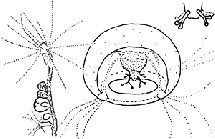
| Intro | | Search taxa | | Browse taxa | | Distributions | | Terminology | | References | | Statistics | | Online sources | | Tutorial | | Log in |
Deep-Sea taxon detailsBougainvilliidae Lütken, 1850
1594 (urn:lsid:marinespecies.org:taxname:1594)
accepted
Family
marine, brackish, fresh,
Lütken, C., 1850. Nogle Bemaerkninger om Medusernes systematiske Inddeling, navnlig med Hensyn til Forbes's History of British Naked-eyed Medusae. Vidensk. Meddr dansk naturh. Foren., 1850 : 15-35., available online at https://www.biodiversitylibrary.org/page/7704526
page(s): 29; note: as Bougainvilleae Lütken, 1850, corrected to Bougainvilliidae by Allman, 1876 [details]
Schuchert, P.; Choong, H.; Galea, H.; Hoeksema, B.; Lindsay, D.; Manko, M.; Pica, D. (2025). World Hydrozoa Database. Bougainvilliidae Lütken, 1850. Accessed through: Glover, A.G.; Higgs, N.; Horton, T. (2025) World Register of Deep-Sea species (WoRDSS) at: https://marinespecies.org/deepsea/aphia.php?p=taxdetails&id=1594 on 2025-05-08
Glover, A.G.; Higgs, N.; Horton, T. (2025). World Register of Deep-Sea species (WoRDSS). Bougainvilliidae Lütken, 1850. Accessed at: https://marinespecies.org/DeepSea/aphia.php?p=taxdetails&id=1594 on 2025-05-08
Date action by 2004-12-21 15:54:05Z created db_admin
original description
Lütken, C., 1850. Nogle Bemaerkninger om Medusernes systematiske Inddeling, navnlig med Hensyn til Forbes's History of British Naked-eyed Medusae. Vidensk. Meddr dansk naturh. Foren., 1850 : 15-35., available online at https://www.biodiversitylibrary.org/page/7704526
page(s): 29; note: as Bougainvilleae Lütken, 1850, corrected to Bougainvilliidae by Allman, 1876 [details] context source (Hexacorallia) Fautin, Daphne G. (2013). Hexacorallians of the World. (look up in IMIS) [details] basis of record Bouillon, J.; Boero, F. (2000). Synopsis of the families and genera of the Hydromedusae of the world, with a list of the worldwide species. <i>Thalassia Salent. 24</i>: 47-296 (look up in IMIS) [details] additional source Calder, D. R. (1988). Shallow-water hydroids of Bermuda. The Athecatae. <em>Royal Ontario Museum Life Sciences Contributions.</em> 148: 1-107. page(s): 12 [details] Available for editors additional source Schuchert, P. (2007). The European athecate hydroids and their medusae (Hydrozoa, Cnidaria): Filifera part 2. <em>Revue suisse de Zoologie.</em> 114: 195-396. page(s): 196 [details]  Present Present  Inaccurate Inaccurate  Introduced: alien Introduced: alien  Containing type locality Containing type locality
From editor or global species database
Diagnosis Hydroids solitary or colonial; hydranths stolonal, branched, or rarely sessile, arising from creeping hydrorhiza; erect colonies monopodial with terminal hydranths, stems monosiphonic or polysiphonic; perisarc terminating either at base of hydranths or forming a pseudohydrotheca; hydranths with one or more whorls of filiform distal tentacles, tentacles confined to narrow zone below hypostome; gonophores free medusae or fixed sporosacs developing either on hydrocauli, stolons, or blastostyles.Medusae bell-shaped; mouth circular, with simple or dichotomously branched oral tentacles inserted distinctly above mouth rim, ending in nematocyst clusters; four radial canals and circular canal; marginal tentacles solid, contractile, either solitary or in clusters, borne on 4, 8, or 16 tentacular bulbs; gonads on manubrium, either forming a continuous ring or in adradial, interradial, or perradial position; adaxial ocelli absent or present. [details] Remark KEY TO THE GENERA OF THE BOUGAINVILLIIDAE: see Schuchert (2007) [details]
|

